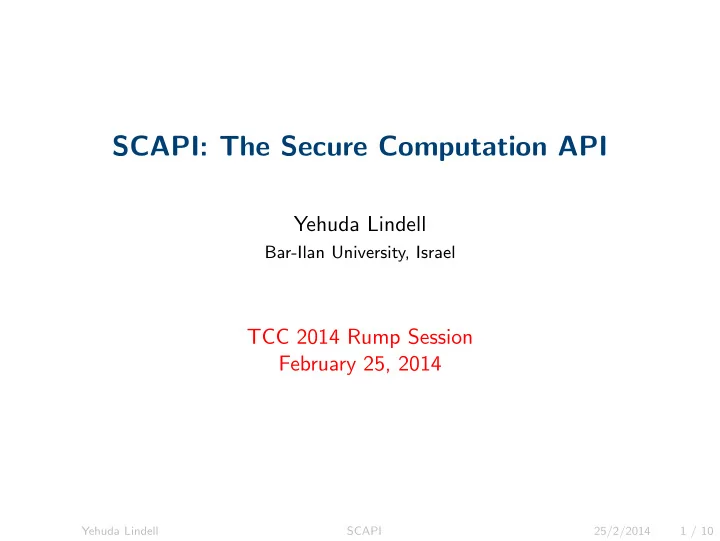

SCAPI: The Secure Computation API Yehuda Lindell Bar-Ilan University, Israel TCC 2014 Rump Session February 25, 2014 Yehuda Lindell SCAPI 25/2/2014 1 / 10
Implementation of Secure Computation The SCAPI Project: S ecure C omputation API ◮ Most implementation projects are aimed at solving a specific problem more efficiently or with better security ◮ SCAPI is an implementation project with no specific problem in mind (it is a general-purpose secure computation library) ◮ SCAPI is open source; we have a long-term commitment (as long as we have money) to the project (bug fixes, additional functionality, improve existing implementations etc.) Yehuda Lindell SCAPI 25/2/2014 2 / 10
Basic Design Decisions ◮ SCAPI is written in Java ◮ Suitable for large projects, and quick implementation ◮ Portability (e.g., secure computation between a mobile device and a server) ◮ Existing libraries (e.g., Bouncy Castle) ◮ The JNI framework: can use libraries and primitives written in native code (and thus inherit their efficiency) Yehuda Lindell SCAPI 25/2/2014 3 / 10
Design Principles ◮ Flexibility: ◮ Cryptographers write protocols in abstract terms (OT, commitment, PRF, etc.) ◮ SCAPI encourages implementation at this abstract level (work with any “DLOG group” and afterwards instantiate with concrete group and concrete library; e.g. EC-group from Miracl) ◮ Can work at many different levels of abstraction, as desired ◮ Extendibility: can add support for any new libraries and implementation by providing wrappers that implement the defined interfaces (we are now adding openSSL) ◮ Efficiency: via JNI can access fast low-level libraries like Miracl, but work at the level of Java and with abstract objects ◮ Ease of use: SCAPI uses terminology that cryptographers are used to; SCAPI is well documented and has been written explicitly with other users in mind Yehuda Lindell SCAPI 25/2/2014 4 / 10
Security Levels ◮ Consider an oblivious transfer protocol that uses a group, a commitment scheme, and a hash function ◮ The theorem stating security of the protocol would say: ◮ Assume that DDH is hard in the group, the commitment is perfectly binding, and the hash function is collision resistant. ◮ Then, the OT protocol is secure. ◮ SCAPI differentiates between security levels by defining hierarchies of interfaces , and protocol constructors can check them Yehuda Lindell SCAPI 25/2/2014 5 / 10
Security Levels SCAPI defines hierarchies of interfaces for security levels Yehuda Lindell SCAPI 25/2/2014 6 / 10
Security Level Use ◮ The OT protocol receives a dlog group, commitment and hash function in its constructor ◮ It checks that: ◮ The dlog group is an instance of DDH ◮ The commitment is an instance of PerfectBinding ◮ The hash function is an instance of CollisionResistant ◮ Security levels are also defined for protocols (semi-honest, covert, malicious, stand-alone, UC secure, and so on) Yehuda Lindell SCAPI 25/2/2014 7 / 10
Layers and Primitives SCAPI has three layers ◮ Basic primitives (discrete log groups, PRFs, PRPs, hash, universal hash, etc.) ◮ Non-interactive schemes (symmetric and asymmetric encryption, MACs, signatures) ◮ Interactive protocols (oblivious transfer, garbled circuits, sigma protocols, ZK, ZKPOK, commitments, etc.) ◮ We are continually adding: OT extensions for semi-honest (ACM CCS 13), JustGarble, wrapper for OpenSSL Yehuda Lindell SCAPI 25/2/2014 8 / 10
Example Usage The Cramer-Shoup Encryption Scheme public interface CramerShoupDDHEnc extends AsymmetricEnc, Cca2 { } public CramerShoupAbs(DlogGroup dlogGroup, CryptographicHash hash, SecureRandom random){ //The Cramer-Shoup encryption scheme must work with a Dlog Group that has DDH security level //and a Hash function that has CollisionResistant security level. If any of this conditions is not //met then cannot construct an object of type Cramer-Shoup encryption scheme; therefore throw exception. if(!(dlogGroup instanceof DDH)){ throw new IllegalArgumentException("The Dlog group has to have DDH security level"); } if(!(hash instanceof CollisionResistant)){ throw new IllegalArgumentException("The hash function has to have CollisionResistant security level"); } // Everything is correct, then sets the member variables and creates object. this.dlogGroup = dlogGroup; qMinusOne = dlogGroup.getOrder().subtract(BigInteger.ONE); this.hash = hash; this.random = random; } Yehuda Lindell SCAPI 25/2/2014 9 / 10
Results – Average of 1000 Runs The Cramer-Shoup Encryption Scheme Encrypt Decrypt Dlog Group Dlog Dlog Hash Hash Type Provider Param Function Provider Time (ms) Time (ms) DlogZpSafePrime CryptoPP 1024 SHA-256 BC 6.072 3.665 DlogZpSafePrime CryptoPP 2048 SHA-256 BC 43.818 26.289 DlogECFp BC P-224 SHA-1 BC 54.171 31.662 DlogECF2m BC B-233 SHA-1 BC 107.316 65.185 DlogECF2m BC K-233 SHA-1 BC 25.292 14.886 DlogECFp Miracl P-224 SHA-1 BC 6.571 3.929 DlogECF2m Miracl B-233 SHA-1 BC 5.819 3.652 DlogECF2m Miracl K-233 SHA-1 BC 2.753 1.787 Yehuda Lindell SCAPI 25/2/2014 10 / 10
Recommend
More recommend